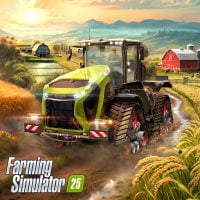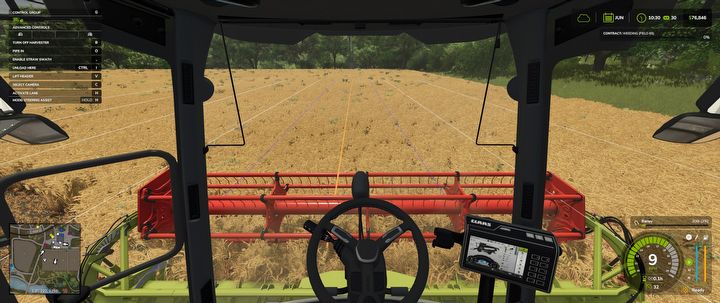Farming Simulator 25 Review - Rustic Charm with Some Minor Bugs
Farming Simulator 25 is like an iPhone - it generally lags a bit behind modern standards, but compared to the previous version, it is the best and has a long list of new features. For regular customers, fans of Farming Simulator, it's an obvious choice!
The review is based on the PC version. It's also relevant to PS5, XSX version(s).

The Farming Simulator series isn't the kind of game that you "complete" in a specific number of hours and that's it. I would call it more of a virtual lifestyle because developing your virtual farm consumes every free moment in the following months and even years. Some people may turn it on "for a moment" to play as a farmer, but you definitely don't hear much about them. Like most complex simulators, it's a game for people who can fully devote themselves to their passion – in this case, agriculture.
Probably for this reason, each installment of Farming Simulator is a small evolution of the previous one. For the person who plays it for the first time, there are only a few novelties, but for fans, there is a whole host of small changes and fixes that they notice with pixel precision. Many new elements are often the implementation of mechanics from the most popular mods created by the game community.
This time is no different. Farming Simulator 25 is a slightly tuned successor of FS19, still not very accessible to beginners. You can notice slightly better graphics, new visual effects, new crops and machines, the inclusion of a few mods, and many minor improvements. This time the main theme is Asia and the new map in this region, although numerous smaller changes somewhat overshadow it.
Asian background for rice cultivation
Traditionally, Farming Simulator 25 allows you to play as a farmer on three maps. The first one takes us to the United States and a place called Riverbend Springs. The second one is Zielonka in Poland, known from the FS19 DLC, and the third one is the heavily advertised Hutan Pantai in Asia. On the first one, the main new thing is the river crossing the map. Zielonka was only slightly modified - so the main novelty is the Asian map.
However, it seemed to me that it was merely a cosmetic addition creating the ambiance for a much larger attraction, which is rice cultivation – one of the most eagerly awaited corps by fans. Along with two types of rice, special machines for its planting and harvesting appeared, as well as the possibility of flooding the rice field with water to grow "wet" rice. The rest of the Asian climate, such as the architecture of the buildings or the deserted city center with high-rise buildings full of neon lights, seems to be lacking flair and attention to detail.
Another new Asian feature is the water buffalo, a new addition to the range of farm animals. Its greatest advantage lies in the production of buffalo milk and the chance to create extremely profitable Mozzarella from it. This is all just a preamble to a much longer list of remaining additions and improvements.
Deformation of the soil in the fog
The most noticeable change is the improvements in the graphics engine. Describing it as a next-gen version may be too much, but the visuals have certainly been enhanced by improved lighting, especially at night, and the addition of fog effects that settle on fields, bodies of water, and lower-lying areas in the morning. This can also include severe weather effects, such as hail or tornadoes, which can potentially destroy crops and thus affect the farm's economy. The rain and the effect of wet tires can now be seen on machines, which realistically collect dirt from the field.
The graphical novelty also includes the long-awaited three-dimensional terrain, and it must be admitted that this is a much more complex deformation mechanism than it seemed to me after watching the trailer. Depending on the machine we use to cross the field, furrows of various thicknesses are created on it. Tractor tire marks are created in a similar way. The depth of the deformed terrain also depends on the degree of softness of a given soil. The best part is that these deeper furrows actually affect the physics of the objects. Trying to drive a tractor quickly across a plowed field causes the vehicle to shake and bounce noticeably. However, I didn't manage to get stuck in the ground bucking the wheels - maybe in time, such an option will come.
All these changes aren't only pleasing to the eye, but above all, they increase realism and improve immersion. They are much more important than the new plants to grow or maps.
- finally, soil deformation mechanics;
- noticeably improved graphics with new lighting and fog effects;
- harsh weather events that can destroy crops;
- innovations in animal breeding;
- GPS and improvement of employees' AI;
- many new buildings and structures to be placed on the map;
- numerous minor changes and improvements.
- still lack of a decent tutorial for beginners;
- annoying physics of object collision;
- disappointing interactions with NPCs;
- various minor bugs and technical glitches.
GG - Goats and GPS
Apart from changes in graphics and soil physics, I also really liked a few other new features. The first one is offspring of animals and dynamic folds. The game now features various stages of animal maturity and the sight of playful young goats, a new addition to the menagerie after the buffaloes, can bring joy even after significant field damage. This isn't just a cosmetic change because the animals can now reproduce, so our herd will increase on its own if we provide the right conditions. It's a pity that there was no option to choose the gender when buying animals. Another helpful change is the option to freely mark out the pasture fence or even remove the fence completely.
Vehicles have finally been equipped with a GPS module, which allows for more efficient field cultivation. The tractor can now maintain a straight line, and we can see which lane to direct it to after turning, which we must do ourselves. However, GPS doesn't just help us; it also improves the performance of AI-controlled workers. We can now choose a field of the most non-standard shape, and AI should be able to handle work on it without constantly getting stuck.
Farming Simulator 25 has also been improved with new buildings and structures that allow you to either stay in your own little ecosystem or, on the contrary, expand your town on the map. Apart from constructing large processing facilities that cost hundreds of thousands, we can now establish small mills, spinning mills, and similar facilities on the edge of our own mini-farm, and then set up a stall by the road to sell our products. The game also has the option to build your own house, which you can finally enter, but you can't decorate it your way. On the map, we will also find public facilities, which with regular deliveries of required materials will turn into a church, museum, or playground.
Government subsidies didn't help
The game's list of new features can be extended extensively - including a TPP camera outside the machine, spinach, peas, and beans among the list of crops, and so on. However, not everything was fixed, not everything was done in such a way as to be effusive with superlatives. The physics of object collisions is still seriously flawed, which means that loading pallets can still be a pain in the ass. Vehicles generally tend to get stuck or even become attached to various objects, and streetcars, once stopped, are welded to the road and unable to move. You have to use the "reset" option too frequently to free your machine, which then teleports it to the starting point instead of next to the blockade, forcing you to waste time getting back. There are quite a lot of annoying inconveniences and various minor bugs.
A big disappointment were the NPC characters you can talk to – they don't contribute much to the game. In theory, they can help us and provide advice, but the text is as vaguely written as the directions on the menu. The game still sorely lacks a proper tutorial on every topic – we only have an introduction explaining the rather obvious mechanics of cultivating the field. You have to find out on your own how to prepare feed for cows and deliver it, or how to use GPS for work.
Farming Simulator 25 is a bit like the latest iPhones – no extravagance, no revolution, a slightly improved, familiar product for regular customers. If you are one of them, you surely already have a pre-order. And if not - there is something to complain about.
Find all our reviews on Metacritic and Opencritic.
Sometimes an abundance, sometimes a disaster
Any statement about Farming Simulator 25, whether it's just a slightly improved version of the old game with a few mods or it introduces significant changes and new features that effectively motivate players to switch to the latest installment, will be true. After all, it all depends on your expectations and how big a fan of running a virtual farm you are. Compared to the previous installments, this is definitely the best one, but a similar opinion was true for Farming 22 and FS19. Farming Simulator 25 is a bit like the latest iPhones – no extravagance, no revolution, a slightly improved, familiar product for regular customers. If you are one of them, you surely already have a pre-order. And if not - there is something to complain about. That's how it is on the farm - either an abundance, or drought, or frost.
Farming Simulator 25
Farming Simulator 25 Review - Rustic Charm with Some Minor Bugs
Farming Simulator 25 is like an iPhone - it generally lags a bit behind modern standards, but compared to the previous version, it is the best and has a long list of new features. For regular customers, fans of Farming Simulator, it's an obvious choice!






